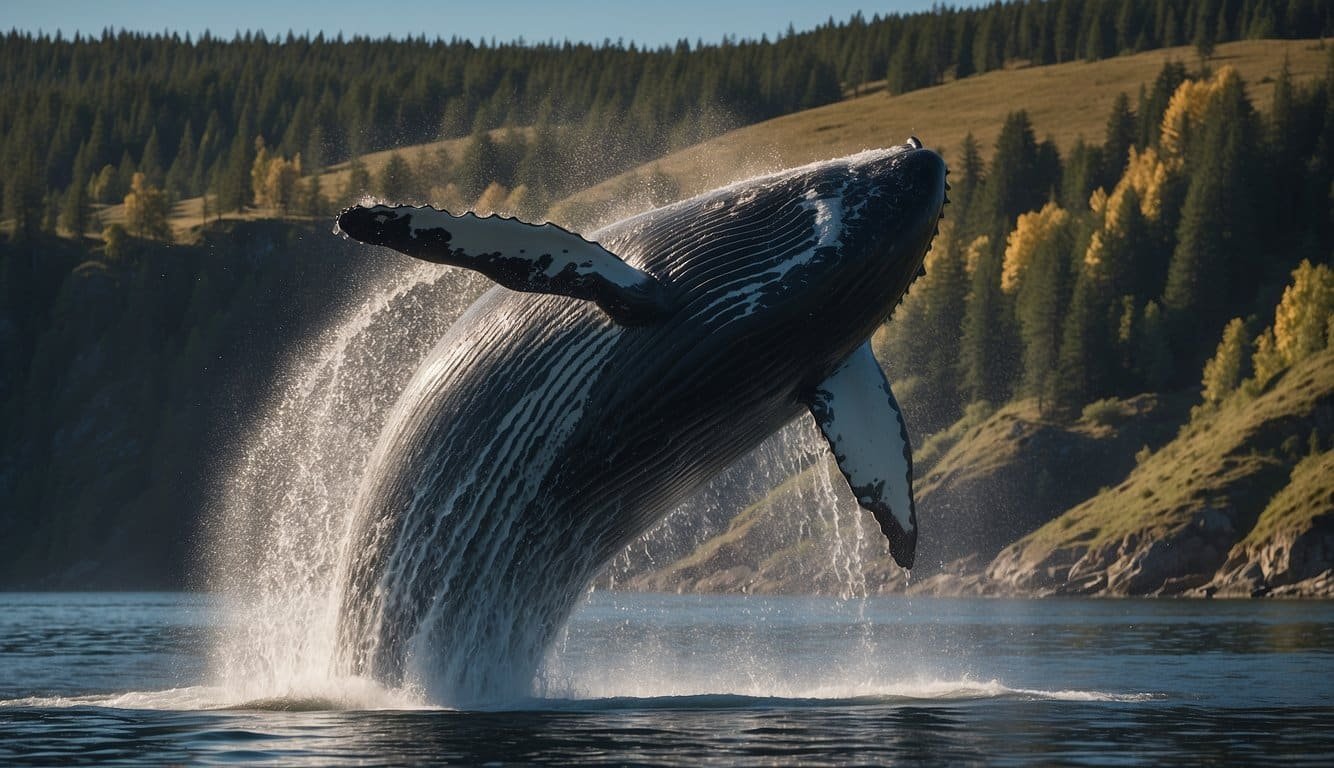Whale Fundamentals

Whales, belonging to the order Cetacea, are amongst the largest and most fascinating mammals in the ocean. There are two major types of whales: the baleen whales, known for their bristle-like filters used to sieve tiny prey from the water, and toothed whales, which include the well-known sperm whale and many dolphin species.
Classification:
- Kingdom: Animalia
- Phylum: Chordata
- Class: Mammalia
- Order: Cetacea
Diet:
- Baleen whales: small fish, krill, and plankton
- Toothed whales: fish, squid, and at times other marine mammals
Communication: Whales are renowned for their complex songs and calls, which can travel for miles underwater, serving various purposes from mating calls to social interactions.
Despite their immense size, many details about whales remain shrouded in mystery. For instance, the intricacies of their societal structures, especially the care for calves within sperm whale pods, are still under study. These giant mammals take an active role in the communal care of their young, a behavior that exemplifies their social nature.
In terms of anatomy, their hearing is crucial; whales rely on their sense of hearing as their primary means of navigation and communication in the often dark marine environments. Scientists seek to understand the structure and function of whale ears, a task that requires cross-species studies due to the dramatic differences in hearing capabilities among whale species.
Diving into the less-known aspects, whales also inspire innovations. For example, the concept of the whale optimization algorithm is an emerging field in resource allocation within wireless networks, drawing parallels from the foraging patterns of humpback whales.
Anatomy and Diet

Whales, as majestic mammals of the ocean, display a fascinating diversity in their anatomy and diet, adapted over millions of years to suit their aquatic lifestyle. From the gargantuan blue whale to the deep-diving sperm whale, these creatures have evolved unique traits for feeding that are as intriguing as they are varied.
Physical Characteristics
Whales come in an array of sizes; the blue whale can reach lengths of up to 100 feet and weigh as much as 200 tons, making it the largest animal on Earth, while the fin whale is the runner-up in size. The insulating blubber layer is crucial for their thermal regulation, and for some species, it can be as thick as 12 inches. Toothed whales, like the sperm whale, possess teeth for grasping prey and are known for their large heads and pronounced jaws. On the other hand, baleen whales, such as the blue whale and fin whale, have plates of baleen made of keratin, the same material as human fingernails, which they use to filter small food like krill and plankton from the water.
- Length: 10-100 feet (toothed whale: up to 60 feet; baleen whale: up to 100 feet)
- Weight: up to 200 tons
- Physical Traits: Blubber, baleen, teeth (toothed whales)
Feeding Habits
Toothed whales, including sperm whales, employ echolocation to hunt, using it to find and capture fast-moving prey deep within the ocean’s dark depths. They predominantly consume squid, including the giant squid, Architeuthis dux, also known as melvillei. On the flip side, the baleen whales gulp enormous amounts of water teeming with tiny creatures like krill and strain them through their baleen plates. The blue whale alone can consume up to 4 tons of krill each day.
- Diet: Squid (toothed whales); Krill, plankton (baleen whales)
- Feeding Mechanisms: Echolocation (toothed whales); Baleen filter-feeding (baleen whales)
Unique Adaptations
Several unique anatomical features set whales apart. Their hearts can weigh as much as an automobile, and their blow, or exhalation, can spray water up to 30 feet into the air. Toothed whales have complex auditory systems for echolocation, allowing them to navigate and detect prey with precision. Baleen whales have an impressive gulp-feeding mechanism, coordinating their mouth and pleat expansion to take in volumes of prey-laden water. These are just a few of the remarkable adaptations that allow whales to thrive in their aquatic environment.
- Heart Size: Extremely large, up to the size of a small car
- Blow: Can reach heights of up to 30 feet
Explore more about the fascinating feeding anatomy of whale sharks or dive into the anatomy and physiology of various whale species. Learn about the filtration mechanisms of baleen whales to truly appreciate the complexity of these sea giants.
Conservation and Threats

Whales, these magnificent marine mammals, face an array of threats from human activities to natural challenges that put their very existence at risk. Effective conservation efforts are crucial to prevent further decline of whale populations and to protect the vast ocean habitats they call home.
Human Impact
Commercial whaling historically decimated numerous whale populations, bringing some species to the brink of extinction. For instance, the plight of the North Atlantic right whales, once pushed perilously close to disappearing by whalers, is a testament to the destructive capacity of unregulated hunting. Even with a ban on commercial whaling, facilitated by the International Whaling Commission, these creatures are still not safe. Issues like ship strikes, fishing gear entanglement, and pollution continue to threaten their recovery.
Natural Challenges
Beyond human-induced hurdles, whales must overcome a plethora of natural challenges. Predators such as orcas may target vulnerable calves during long migration routes, while shifting climates affect the icy habitats in the Arctic that some species rely on. These changes can disrupt food availability, affecting the whales’ ability to thrive and maintain healthy populations.
Scientific Study
Through dedicated research, scientists are better understanding the complex lives of whales, from their intricate communication to their social structures. This information is vital for informed conservation. The southern right whale, for example, has been studied using historical whaling records to predict present distribution patterns and assess current threats. Such efforts offer a beacon of hope for safeguarding the future of these majestic mammals within our marine environment.

